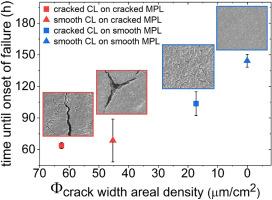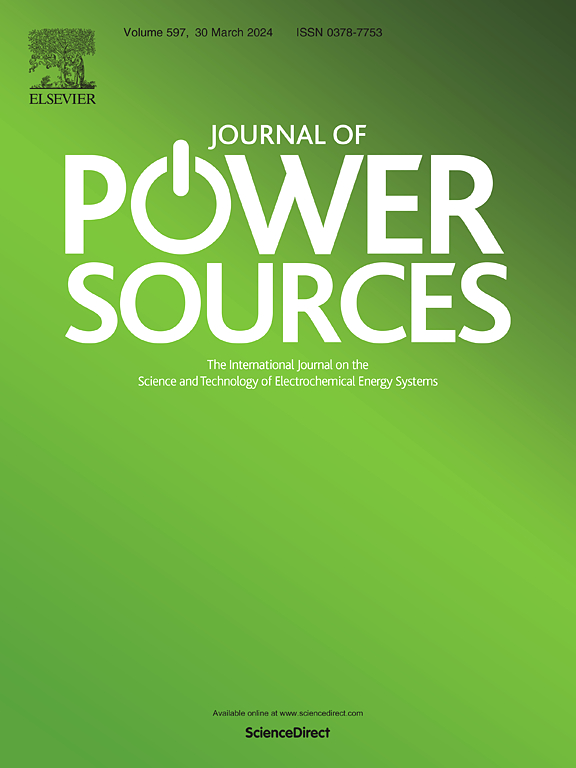电极裂纹尺寸对聚合物电解质膜燃料电池耐久性的影响
IF 8.1
2区 工程技术
Q1 CHEMISTRY, PHYSICAL
引用次数: 0
摘要
聚合物电解质膜燃料电池(PEMFC)中的电极裂纹与早期故障有关。在这项工作中,我们使用化学机械加速应力测试 (AST) 来研究气体扩散电极 (GDE) 裂纹对膜电极组件 (MEA) 耐用性的影响。利用油墨配方和材料选择策略系统地调整了电极裂缝尺寸。用一个参数来描述裂纹宽度均密度 (ΦCW),以量化电极表面的不连续程度。开路电压(OCV)瞬态分析用于确定 MEA 的失效机制,并描述其与ΦCW 的函数关系。较小的电极级裂纹(微米级)使工作寿命缩短了 28%,而从不连续性微孔层 (MPL) 涂层扩展的较大裂纹则使工作寿命缩短了 56%。这项工作强调,需要考虑缺陷公差的材料加工策略,以限制 PEMFC 中的膜故障。本文章由计算机程序翻译,如有差异,请以英文原文为准。

The influence of electrode crack dimensions on the durability of polymer electrolyte membrane fuel cells
Electrode cracks in polymer electrolyte membrane fuel cells (PEMFCs) are correlated with early onset failures. In this work we investigate the influence of cracked gas diffusion electrodes (GDEs) on the durability of the membrane electrode assembly (MEA) using a combined chemical-mechanical accelerated stress test (AST). Electrode crack dimensions were systematically tuned using ink formulations and material selection strategies. A parameter to describe the crack width areal density (ΦCW) was used to quantify the degree of discontinuity in the electrode surfaces. Open circuit voltage (OCV) transient analyses were used to benchmark and characterize the failure mechanisms in the MEAs as a function of the ΦCW. While smaller electrode-level cracks, on the order of microns, yielded a 28 % decrease in operating lifetime, larger cracks that propagated from a discontinuous, microporous layer (MPL) coating, decreased the operating lifetime by 56 %. This work emphasizes the need for material processing strategies that consider defect tolerances to limit membrane failures in PEMFCs.
求助全文
通过发布文献求助,成功后即可免费获取论文全文。
去求助
来源期刊

Journal of Power Sources
工程技术-电化学
CiteScore
16.40
自引率
6.50%
发文量
1249
审稿时长
36 days
期刊介绍:
The Journal of Power Sources is a publication catering to researchers and technologists interested in various aspects of the science, technology, and applications of electrochemical power sources. It covers original research and reviews on primary and secondary batteries, fuel cells, supercapacitors, and photo-electrochemical cells.
Topics considered include the research, development and applications of nanomaterials and novel componentry for these devices. Examples of applications of these electrochemical power sources include:
• Portable electronics
• Electric and Hybrid Electric Vehicles
• Uninterruptible Power Supply (UPS) systems
• Storage of renewable energy
• Satellites and deep space probes
• Boats and ships, drones and aircrafts
• Wearable energy storage systems
 求助内容:
求助内容: 应助结果提醒方式:
应助结果提醒方式:


